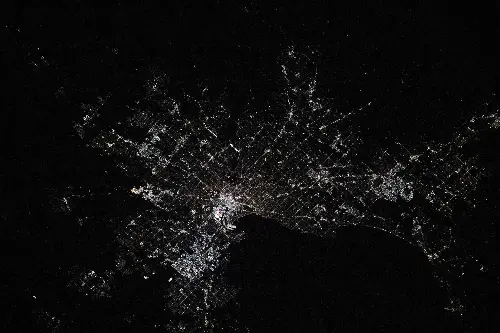
A U.S. astronaut has captured an image of Australia's second most populated city from the International Space Station.
Don Pettit captured the image of Melbourne from the space station on October 9, 2024.
The image was taken as the station, which orbits at an altitude of between 370 to 460 kilometers, 230 to 285 miles, above Earth, was approximately 270 miles above the city,
Melbourne, the capital city of the state of Victoria, is the second most populated city in Australia as of June 2023, according to census data on the Australian Bureau of Statistics, with a population of 5,207,145 behind Sydney with 5,450,496.
While Melbourne is not the most populated city, it had the largest growth in population between 2022-2023, of 167,500 people.
The man who took the photo, Pettit, was selected by NASA to be an astronaut in April 1996, and he has since accumulated more than 370 days in space and over 13 spacewalk hours.
He traveled to the International Space Station on September 11, 2024, accompanied by cosmonauts Alexey Ovchinin and Ivan Vagner, and will spend around six months conducting science experiments and maintaining the space station.
He has been sharing images from space on his X, formerly Twitter, account recently of Kathmandu, Nepal and an image of the Amazon basin at night.
The International Space Station has been in orbit for 25 years and more than 270 astronauts have visited it since it's launch, according to NASA.
Astronauts onboard often take photos with handheld digital camera through the windows of the station's cupola, according to a NASA report. Iconic images taken previously include the night lights of northwest France and southeast England and a volcanic plume issuing from Mt. Etna, in Sicily.
Elements of the space station were built in various countries, including the U.S., Canada, Japan, and Europe in the late 1980s, and in 1993 Russia was also invited to participate.
It is the largest human-made object to ever orbit the Earth and its structure measures 109 meters by 51 meters.
The station's orbit is not synchronized with our planet's, meaning that it travels over places between latitudes 52 degrees north and 52 degrees south at different points in the day, according to NASA.
This orbit reportedly enables those on board the station to capture images of a specific location from different angles with altering light conditions.
This means that they can capture images of infrequent and short-term events, such as natural disasters, which allows the station to provide data to support disaster response organizations.
Do you have a story Newsweek should be covering? Do you have any questions about this story? Contact [email protected].
Related Articles
- Where Are NASA's Voyagers Now and What Happens to Them Next?
- How To See ATLAS Comet Next Week as It Goes Headless For Halloween
- Stranded NASA SpaceX Crew-8 Astronauts Set for Splashdown Within Hours
